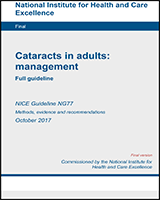From: 12, Preventing and managing complications

Cataracts in adults: management.
NICE Guideline, No. 77.
London: National Institute for Health and Care Excellence (NICE); 2017 Oct.
Copyright © NICE 2017.
NCBI Bookshelf. A service of the National Library of Medicine, National Institutes of Health.